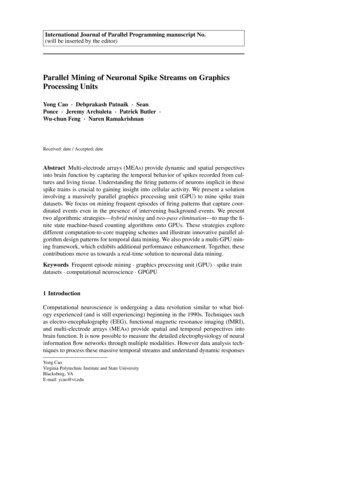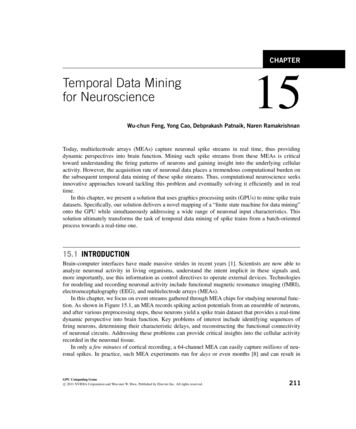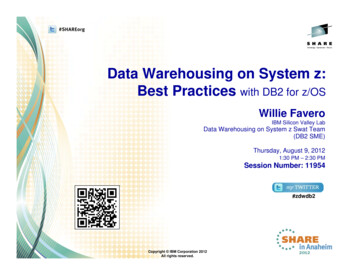
Transcription
International Journal of Parallel Programming manuscript No.(will be inserted by the editor)Parallel Mining of Neuronal Spike Streams on GraphicsProcessing UnitsYong Cao · Debprakash Patnaik · SeanPonce · Jeremy Archuleta · Patrick Butler ·Wu-chun Feng · Naren RamakrishnanReceived: date / Accepted: dateAbstract Multi-electrode arrays (MEAs) provide dynamic and spatial perspectivesinto brain function by capturing the temporal behavior of spikes recorded from cultures and living tissue. Understanding the firing patterns of neurons implicit in thesespike trains is crucial to gaining insight into cellular activity. We present a solutioninvolving a massively parallel graphics processing unit (GPU) to mine spike traindatasets. We focus on mining frequent episodes of firing patterns that capture coordinated events even in the presence of intervening background events. We presenttwo algorithmic strategies—hybrid mining and two-pass elimination—to map the finite state machine-based counting algorithms onto GPUs. These strategies exploredifferent computation-to-core mapping schemes and illustrate innovative parallel algorithm design patterns for temporal data mining. We also provide a multi-GPU mining framework, which exhibits additional performance enhancement. Together, thesecontributions move us towards a real-time solution to neuronal data mining.Keywords Frequent episode mining · graphics processing unit (GPU) · spike traindatasets · computational neuroscience · GPGPU1 IntroductionComputational neuroscience is undergoing a data revolution similar to what biology experienced (and is still experiencing) beginning in the 1990s. Techniques suchas electro-encephalography (EEG), functional magnetic resonance imaging (fMRI),and multi-electrode arrays (MEAs) provide spatial and temporal perspectives intobrain function. It is now possible to measure the detailed electrophysiology of neuralinformation flow networks through multiple modalities. However data analysis techniques to process these massive temporal streams and understand dynamic responsesYong CaoVirginia Polytechnic Institute and State UniversityBlacksburg, VAE-mail: ycao@vt.edu
2Yong Cao et al.to stimuli and environmental factors are still in their infancy. Data mining algorithmsare important in understanding the pathways that get triggered by sensory input andto expose the underlying anatomical connectivity of networks. Uncovering such networks can help understand the response of information pathways to the applicationof different kinds of stimuli.A parallel revolution is happening in the related area of brain-computer interfaces [1]. Scientists are now able to not only analyze neuronal activity in living organisms, but also to understand the intent implicit in these signals and use this information as control directives to operate external devices. In a landmark study [14], Serruya et al. described how hands-free operation of a cursor can be achieved in real-timeby monitoring the activities of just a few neurons in the motor cortex of a monkey.A brain-computer interface for controlling a humanoid robot using signals recordedfrom human scalp is described in [3]. Again, the real-time, responsive behavior of theinterface is a remarkable feature that bodes well for its success. Even cognitive understanding can now be achieved algorithmically: Mitchell et al. [12] describe how theyare able to map the semantics of words and nouns to regions of brain activity. Thereare now many technologies for modeling and recording neuronal activity includingfMRI (functional magnetic resonance imaging), EEG (electroencephalography), andmulti-electrode arrays (MEAs). In this paper, we focus exclusively on event streamsgathered through multi-electrode array (MEA) chips for studying neuronal functionalthough our algorithms and implementations are applicable to a wider variety ofdomains.An MEA records spiking action potentials from an ensemble of neurons which,after various pre-processing steps, yields a spike train dataset providing real-time,dynamic, perspectives into brain function (see Figure 1). Identifying sequences (e.g.,cascades) of firing neurons, determining their characteristic delays, and reconstructing the functional connectivity of neuronal circuits are key problems of interest. Thisprovides critical insights into the cellular activity recorded in the neuronal tissue.A spike train dataset can be modeled as a discrete symbol stream, where eachsymbol/event type corresponds to a specific neuron (or clump of neurons) and thedataset encodes occurrence times of these events. One class of patterns that is ofinterest is frequent episodes which are repetitive patterns of the form A B C,i.e., event A is followed by (not necessarily consecutively) B is followed by C. Thisis the primary class of patterns studied here.With rapid developments in instrumentation and data acquisition technology, thesize of event streams recorded by MEAs has concomitantly grown, leading us toexhaust the abilities of serial computation. For instance, just a few minutes of cortical recording from a 64-channel MEA can easily generate millions of spikes. Furthermore, it is not uncommon for a typical MEA experiment to span days or evenmonths [15]. Hence it is imperative that algorithms support fast, real-time computation, data mining, and visualization of patterns.In this paper, we address the challenge of finding a real-time solution for temporaldata mining, which is under high demand by neuroscientists. Instead of providing aparallel data mining system on a supercomputer, we seek a much more economicalsolution on a desktop computer powered by many-core graphics processing units(GPUs). General-purpose computing on the GPU (GPGPU) gives us an alternative
Parallel Mining of Neuronal Spike Streams on Graphics Processing Units3GPGPUFrequent EpisodesMicro-electrode ArrayAction Potentials from real neuron cellsFig. 1 Chip-on-Chip Neuroscience. Spike trains recorded from a multi-electrode array (MEA) are minedby a GPU to yield frequent episodes which can be summarized to reconstruct the underlying neuronalcircuitry.approach for solving data mining problems in a parallel computing fashion. As iswell known, GPUs are designed to shine for a special type of applications—dataparallel applications—for which it is easy to map independent computation units ontothe processing cores of GPU. However, temporal data mining does not fall into thiscategory of applications and makes it difficult to fully utilize the computational powerof GPU. In this paper, we study the challenge of creating an intuitive and balancedcomputation-to-core mapping scheme for GPUs and propose real-time solutions withsignificant performance increases compared with traditional CPU implementation.More specifically, our technical contributions are:1. A hybrid mining approach that leverages the advantages of two computation-tocore mapping schemes and automatically scales according to the number of inputepisodes.2. A two-pass approach that first performs an episode elimination step with relaxedconstraints, resulting in a large performance gain. The potential false positives introduced in the first pass are then eliminated in a second pass. In both, we employcomputation-to-core mapping schemes suitable for frequent episode mining fullyutilize the massively parallel computing architecture of GPUs.3. A multi-GPU mining implementation that further enhances the performance ofmining of massive datasets.This paper extends our previous work [4] by providing a multi-GPU implementation of the episode mining algorithm and a detailed performance analysis comparingthe multi-GPU implementation with our original approach.
4Yong Cao et al.2 Problem StatementA spike train dataset can be modeled as an event stream, where each symbol/eventtype corresponds to a specific neuron (or clump of neurons) and the dataset encodesoccurrence times of these events over the time course.Definition 1 An event stream is denoted by a sequence of events,h(E1 , t1 ), (E2 , t2 ), . . . (En , tn )iwhere n is the total number of events. Each event (Ei , ti ) is characterized by anevent type Ei and a time of occurrence ti . The sequence is ordered by time i.e. ti ti 1 i 1, . . . , n 1 and Ei ’s are drawn from a finite set ξ.One class of interesting patterns that we wish to discover are frequently occurringgroups of events (i.e., firing cascades of neurons) with some constraints on orderingand timing of these events. This is captured by the notion of episodes, the originalframework for which was proposed by Mannila et al [11].Definition 2 An (serial) episode α is an ordered tuple of event types Vα ξ.For example (A B C D) is a 4-node serial episode, and it capturesthe pattern that neuron A fires, followed by neurons B, C and D in that order, but notnecessarily without intervening ‘junk’ firings of neurons (even possibly neurons A,B, C, or D). This ability to intersperse noise or don’t care states, of arbitrary length,between the event symbols in the definition of an episode is what makes these patternsnon-trivial, useful, and comprehensible. Serial episodes can also have repeated eventtypes, for example, (A B A D) is an episode where the event A occurstwice, once before B and again after B and before D.Frequency (or Support) of an episode: The notion of frequency of an episode canbe defined in several ways. In [11], it is defined as the fraction of windows in whichthe episode occurs. Another measure of frequency is the non-overlapped count whichis the size of the largest set of non-overlapped occurrences of an episode expressedas a fraction of the total number of events in the data. Two occurrences are nonoverlapped if no event of one occurrence appears in between the events of the other.In the event stream shown in the following example (1), there are at most two nonoverlapped occurrences of the episode A B, although there are 8 occurrences intotal.h(A, 1), (A, 2), (B, 5), (B, 8), (A, 10), (A, 13), (C, 15), (B, 18), (C, 20)i (1)We use the non-overlapped occurrence count as the frequency or support measure of choice due to its strong theoretical properties under a generative model ofevents [9]. It has also been argued in [13] that, for the neuroscience application,counting non-overlapped occurrences is natural because episodes then correspondto causative, “syn-fire”, chains that happen at different times again and again.Temporal constraints: Besides the frequency threshold, a further level of constraint can be imposed on the definition of episodes. In multi-neuronal datasets, if
Parallel Mining of Neuronal Spike Streams on Graphics Processing Units5one would like to infer that neuron A’s firings cause a neuron B to fire, then spikesfrom neuron B cannot occur immediately or spontaneously after A’s spikes due to axonal conduction delays. These spikes cannot also occur too much later than A for thesame reason. Such minimum and maximum inter-event delays are common in otherapplication domains as well. Hence we place inter-event time constraints betweenconsecutive pairs of events giving rise to episodes such as:(t1low ,t1high ](t2low ,t2high ](A B C).In a given occurrence of episode A B C, let tA , tB , and tC denote the timesof occurrence of corresponding event types. A valid occurrence of the serial episodesatisfiest1low (tB tA ) t1high ; t2low (tC tB ) t2high .In general, an N -node serial episode is associated with N 1 inter-event constraints.(5,10]In example (1) there is exactly one occurrence of the episode A Bsatisfying the desired inter-event constraints, i.e., h(A, 2), (B, 8), (C, 20)i.The problem we address in this paper is defined as follows.(10,15] CPROBLEM: Given an event stream {(Ei , ti )}, i {1 . . . n}, a set of inter-eventconstraints I {(tklow , tkhigh ]},k {1 . . . l}, find all serial episodes α of the form:(1)α (1)(tlow ,thigh ] EhE(1)(2)(N 1)(tlow(N 1),thigh ]. . . E(N ) isuch that the non-overlapped occurrence counts of each episode α is θ, a user(.)(.)specified threshold. Here E(.) ’s are the event types in the episode α and (tlow , thigh ]’s I are the corresponding inter-event constraints.Typically in neuroscience data the number of frequent episodes range from 100to 1000 depending on the frequency (i.e. support) threshold. In real data frequentepisodes of size larger than 10 (i.e. having more than 10 event types) are seldomseen.3 Prior WorkWe review prior work in two categories: mining frequent episodes and data miningusing GPGPUs.Mining Frequent Episodes: The overall mining procedure for frequent episodes isbased on level-wise mining. Within this framework there are two broad classes ofalgorithms: window-based [11] and state machine-based [8, 9], and they primarilydiffer in how they define the frequency of an episode. The window-based algorithmsdefine frequency of an episode as the fraction of windows on the event sequencein which the episode occurs. The state machine-based algorithms are more efficientand define frequency as the size of largest set of non-overlapped occurrences of anepisode. Within the class of state machine algorithms, serial episode discovery using non-overlapped counts was described in [9], and their extension to temporal
6Yong Cao et al.constraints is given in [13]. With the introduction of temporal constraints the statemachine-based algorithms become more complicated. They must keep track of whatpart of an episode has been seen, which event is expected next and, when episodesinterleave, they must make a decision of which events to be used in the formation ofan episode.Data Mining using GPGPUs: Many researchers have harnessed the capabilities ofGPGPUs for data mining. The key to porting a data mining algorithm onto a GPGPUis to, in one sense, “dumb it down” or simplify it. Specifically, the algorithms need toreduce the use of conditionals, branching, and complex decision constraints, whichare not easily parallelizable on a GPU, and thus adversely impact performance. However, designing algorithms under such constraints require significant reworking to fitthis architecture, and unfortunately, temporal episode mining falls in this category.There are many emerging publications in this area but due to space restrictions, wesurvey only a few here. The SIGKDD tutorial by Guha et al. [7] provides a gentle introduction to the aspects of data mining on the GPU through problems like k-meansclustering, reverse nearest neighbor (RNN), discrete wavelet transform (DWT), andsorting networks. In [5], a bitmap technique is proposed to support counting and isused to design GPGPU variants of Apriori and k-means clustering. This work alsoproposes co-processing for itemset mining where the complicated tie data structureis kept and updated in the main memory of CPU and only the itemset counting isexecuted in parallel on the GPU. A sorting algorithm on the GPU with applicationsto frequency counting and histogram construction is discussed in [6] which essentially recreates sorting networks on the GPU. Li et al. [10] present a ‘cut-and-stitch’algorithm for approximate learning of Kalman filters. Although this is not a GPGPUsolution per se, we point out that our proposed approach shares with this work thedifficulties of mining temporal behavior in a parallel context.4 GPU ArchitectureTo understand the algorithmic details behind our approach, we provide a brief overviewof the GPU and its architecture.The initial purpose of specialized GPUs was to accelerate the display of 2D and3D graphics, much in the same way that the FPU focused on accelerating floatingpoint instructions. However, the advances of GPU’s many-core architecture, coupledwith extraordinary speed-ups of application “toy” benchmarks on the specializedGPUs, led GPU vendors to transform the GPU from a specialized processor to ageneral-purpose graphics processing unit (GPGPU), such as the NVIDIA GTX 280,as shown in Figure 2. GPUs provide a massively parallel computing architecture thatcan support concurrent execution of tens of thousands of threads and manage trillions of threads at the same time. To lessen the steep learning curve, GPU vendorsalso introduced programming environments, such as the NVIDIA’s Compute UnifiedDevice Architecture (CUDA).Processing Elements: The basic execution unit on the GTX 280 is a scalar processing core, of which 8 together form a multiprocessor. The number of multiprocessorsand processor clock frequency depends on the make and model of the GPU. For ex-
Parallel Mining of Neuronal Spike Streams on Graphics Processing Units7Fig. 2 Architecture of the NVIDIA GTX 280 GPU.ample, GTX 280 has 30 multiprocessors and totally 240 cores, where each of thecores runs at a speed of 1.296 MHz. GPU multiprocessors execute in SIMT (SingleInstruction, Multiple Thread) fashion, which is similar in nature to SIMD (SingleInstruction, Multiple Data) execution. Each multiprocessor can manage the concurrent execution of a maximum 1024 threads, of which 32 forms a warp. Warp is theminimum threads set that is scheduled independently to run on multiprocessors inparallel. Therefore, GTX 280 can execute at least 960 threads in parallel at any givenmoment. Since each multiprocessor has only one instruction fetch unit, all threads ina warp must execute the same instruction in a GPU clock cycle. However, if a branchinstruction causes the execution of diverged codepaths within a warp, all differentcodepaths have to be executed sequentially, which implies performance slowdown.Memory Hierarchy: The GTX 280 contains multiple forms of memory. Beginningwith the furthest from the GPU processing elements, the device memory is locatedoff-chip on the graphics card and provides the main source of storage for the GPUwhile being accessible from the CPU and GPU. Each multiprocessor on the GPUcontains three caches — a texture cache, constant cache, and shared memory. Thetexture cache and constant cache are both read-only memory providing fast access toimmutable data. Shared memory, on the other hand, is read-write to provide each corewith fast access to the shared address space of a thread block within a multiprocessor.Finally, on each core resides a plethora of registers such that there exists minimalreliance on local memory resident off-chip on the device memory.Parallelism Abstractions: At the highest level, the CUDA programming model requires the programmer to offload functionality to the GPU as a compute kernel. Thiskernel is evaluated as a set of thread blocks logically arranged in a grid to facilitateorganization. In turn, each block contains a set of threads, which will be executed onthe same multiprocessor, with the threads scheduled in warps, as mentioned above.CUDA allows a two-dimensional grid organization. Each grid can have a maximum65, 535 65, 535 blocks and each block can have a maximum of 512 threads. It
8Yong Cao et al.Algorithm 1 Serial Episode Mining(1)(1)(tlow ,thigh ]Input: Candidate N -node episode α hE(1) . . . E(N ) i and event sequence S {(Ei , ti ) i 1 . . . n}.Output: Count of non-overlapped occurrences of α satisfying inter-event constraints1: count 0; s [[], . . . , []] //List of α lists2: for all (E, t) S do3:for i α down to 1 do4:E(i) ith event type of α5:if E E(i) then6:iprev i 17:if i 1 then8:k s[iprev ] 9:while k 0 do10:tprev s[iprev , k](i)(i)prevprev11:if tlow t tprev thighthen12:if i α 1 then13:count ; s [[], . . . , []]; break Line: 314:else15:s[i] s[i] t16:break Line: 917:k k 118:else19:s[i] s[i] t20: RETURN countmeans CUDA-based applications can create and manage more than 2 trillion threadsfor massively parallel computing.5 ApproachOur solution approach is based on a state machine algorithm with inter-event constraints [13]. There are two major phases of this algorithm: generating episode candidates and counting these episodes. We focus on the latter since it is the key performance bottleneck, typically by a few orders of magnitude. Therefore, our focus inthis paper is on novel algorithm design for accelerating episode counting on GPUs.We leave the execution of candidate generation on CPU.Let us first introduce the standard sequential counting algorithm for mining frequent episodes with inter-event constraints. In Algorithm 1, we outline the serialcounting procedure for a single episode α. The algorithm maintains a data structures which is a list of lists. Each list s[k] in s corresponds to an event type E(k) α andstores the times of occurrences of those events with event-type E(k) which satisfy(k 1)(k 1)the inter-event constraint (tlow , thigh ] with at least one entry tj s[k 1]. Thisrequirement is relaxed for s[0], thus every time an event E(0) is seen in the data itsoccurrence time is pushed into s[0].When an event of type E(k) , 2 k N at time t is seen, we look for an entry(k 1)(k 1)tj s[k 1] such that t tj (tlow , thigh ]. Therefore, if we are able to addthe event to the list s[k], it implies that there exists at least one previous event with
Parallel Mining of Neuronal Spike Streams on Graphics Processing Units9event-type E(k 1) in the data stream for the current event which satisfies the interevent constraint between E(k 1) and E(k) . Applying this argument recursively, if weare able to add an event with event-type E( α ) to its corresponding list in s, thenthere exists a sequence of events corresponding to each event type in α satisfying therespective inter-event constraints. Such an event marks the end of an occurrence afterwhich the count for α is incremented and the data structure s is reinitialized. Figure(5,10](10,15]3 illustrates the data structure s for counting A B C.The maximality of the left-most and inner-most occurrence counts for a generalserial episode has been shown in [9]. Similar arguments hold for the case of serialepisodes with inter-event constraints and are not shown here for lack of space.Events:A A B B A A C B CTimes: 1A25(5,10]810 13 15 18 20Bs[A]1s[B]8218(10,15]Cs[C]201013(5,10]Fig. 3 Illustration of the data structure s for counting A B(10,15] CIn the next two sections, we first present a hybrid approach for counting Mepisodes on the massively parallel computing architecture of GPUs. The approachleverages the advantages of two different computation-to-core mapping schemes,where the highest level of parallelism is achieved. We then propose a two-pass counting approach, where the first counting pass eliminates most of unsupported episodesand the second counting pass completes the counting tasks for the remaining episodes.Since the first counting pass uses a less complex algorithm the execution time savedat this step contributes to an overall performance gain even we though go throughtwo-pass counting.5.1 A Hybrid ApproachTo parallelize the sequential counting algorithm on GPU, we need to segment theoverall computation into independent units that can be mapped onto GPU cores andexecuted in parallel to fully utilize GPU resources. Different computation-to-coremapping schemes can result in different levels of parallelism, which are suitablefor different inputs for the counting algorithm. We design two mapping schemesfor counting M episodes: 1) one thread for counting each episode; and 2) multiple
10Yong Cao et al.threads per episode. Each mapping scheme has its own advantages and disadvantages when counting different numbers of episodes. We propose a hybrid countingapproach that can sense the input condition, so that the optimized level of parallelismcan be chosen to achieve the best performance. Let us present the detail of eachmapping scheme and how our hybrid approach optimizes the counting by selectingbetween different mapping schemes according to the number of input episodes M .Per Thread Per Episode (PTPE). One heuristic for segmenting computation intoparallelizable units is to enforce the maximum independence between these units, sothat minimum effort is needed to combine the results from different units. An intuitivemapping scheme is to ask each GPU thread to count support for one episode. Sincethere is no computational dependency between the counting of different episodes, allcounting threads can be executed in parallel with no result/data synchronization atthe end of the execution. In our implementation, we simply implement Algorithm 1as the CUDA kernel for each GPU thread, and create M threads to cover the countingof all input episodes.This mapping scheme, PTPE, is very intuitive and simple. It fits perfectly toGPU’s massive data-parallel architecture. However, there is one major disadvantageof this mapping scheme for episode counting: if the number of episodes M is smallerthan a certain threshold, the GPU resource is underutilized. As we mentioned in Section 4, the GTX 280 GPU is capable of executing 960 threads in parallel. Since wegenerate one thread for counting one episode, if the number of episodes M is lessthan 960, saying M 1 in the extreme case, the most of GPU cores are left idle, andGPU resource is heavily underutilized.Multiple Threads Per Episode (MTPE). Due to inefficiencies in resource usagewhen M is small, we seek to achieve a higher level of parallelism within the countingof a single episode, so that multiple threads are created for counting one episode. Thebasic idea is to segment the input event stream into segments of sub-streams and mapthe counting in one segment onto one thread. Therefore, in this new computationto-core mapping scheme, MTPE, we increase the level of parallelism by introducingparallel counting of multiple segments of the input stream. If the number of the segments is R (which is controllable by the counting algorithm), the total number ofthreads we generate is M R. We need to ensure that M R is larger enough tofully utilize GPU processing cores.The disadvantage of the mapping scheme MTPE is the extra step needed to mergethe sub-counts of all segments for the final count. In this step, we can not simply addall the sub-counts together for the final count, because there are cases that an occurrence of an episode might be divided by the segmentation of the input stream.Additional work is needed to concatenate the divided occurrence between neighboring segments. The bigger the number of segments R is, the more computation isintroduced.Let us discuss the detail about how this two-step, Counting and Merging, mapping scheme is designed. When we divide the input stream into segments, there arechances that some occurrences of an episode span across the boundaries of consecutive segments. As an example, see Fig. 4 which depicts a data sequence divided intotwo segments. The shaded rectangles on the top mark the non-overlapped occurrencesh1 . . . h4 of an episode (A B C) (assume for now that inter-event constraints
Parallel Mining of Neuronal Spike Streams on Graphics Processing UnitsSegment 1h1EventSequenceABg1α1 : count 1Segment 2h2CAh3BACg2BAC Bg311α0 : count 4h4CABCg4α2 : count 2Partial occurrenceFig. 4 Illustration of splitting a data sequence into segments and counting within each segment.are always satisfied), as seen by a state machine α0 on the unified event sequence.α0 is thus the reference (serial) state machine. Let α1 and α2 be the state machinescounting occurrences in segment 1 and segment 2 respectively. During the Countingstep, α1 and α2 are executed in parallel, and each state machine can see a local viewof the episode occurrences, which are shown by empty rectangles below the eventsequence. α1 sees the occurrence g1 and a partial occurrence g2 . For α2 , it will firstsee the occurrence g3 and therefore miss h3 before moving onto g4 .We propose Counting and Merging steps that use multiple state machines in eachsegment, so that the counting of a segment is able to anticipate partial occurrencesnear boundaries. Let us explain in detail why multiple state machines are necessary,and how we design the Counting step and Merging step to maintain the correctnessof counting.E(1)E(2)E(N ).Possible locations of splitFig. 5 Illustration of different possibilities of an occurrence splitting across two adjacent data segments.(1)(1)(tlow ,thigh ]Assume that we are counting an episode α hE(1) . . . E(N ) i, thedata sequence is divided into P segments, and events in the pth data segment are inthe range (τp , τp 1 ]. An occurrence of episode α can be split across two adjacentsegments in at least N ways as shown in Figure 5. For each possible split, we needone state machine, αpk , 0 k N 1, to count the second segment, starting atPk (i)t τp i 1 thigh . So we have N different state machines all counting occurrencesof episode α using Algorithm 1, handling all possible cases of split between currentsegment and previous segment.For each segment p, the Counting step is designed as follows, and illustrated inFigure 6.1. Each state machine αpk maintains its own count countkp .2. αpk does not increment count for occurrences ending at time t τp .
12Yong Cao et al.Event sequenceαp0τpτp 1Segment-pcount0pa0pb0pτpa1pαp1count1pb1p(1)τp thighαpN 1τp PN 1i 1 1aNp 1countNp 1bNpτp 1 (i)thighPN 1 (i)i 1thighFig. 6 Illustration of a Counting step.3. αpk stores the end time of the first occurrence that completes at time t, τp t PN 1 (i)τp i 1 thigh . Let this be akp . If there is no such occurrence akp is set to τp .4. αpk on reaching end of the segment, crosses over into the next segment to comPN 1 (i)pletes the current partial occurrence and continues until t τp 1 i 1 thigh .Let the end time of this occurrence be bkp . Note that count is not incremented forthis occurrence. In case the occurrence cannot be completed bkp is set to τp 1 .The result of the Counting step for each segment p is tuples of (akp , countkp , bkp ).Based on these results, we design our Merging step for pairs o
3.A multi-GPU mining implementation that further enhances the performance of mining of massive datasets. This paper extends our previous work [4] by providing a multi-GPU implementa-tion of the episode mining algorithm and a detailed performance analysis comparing the multi-GPU implementation with our original approach.










